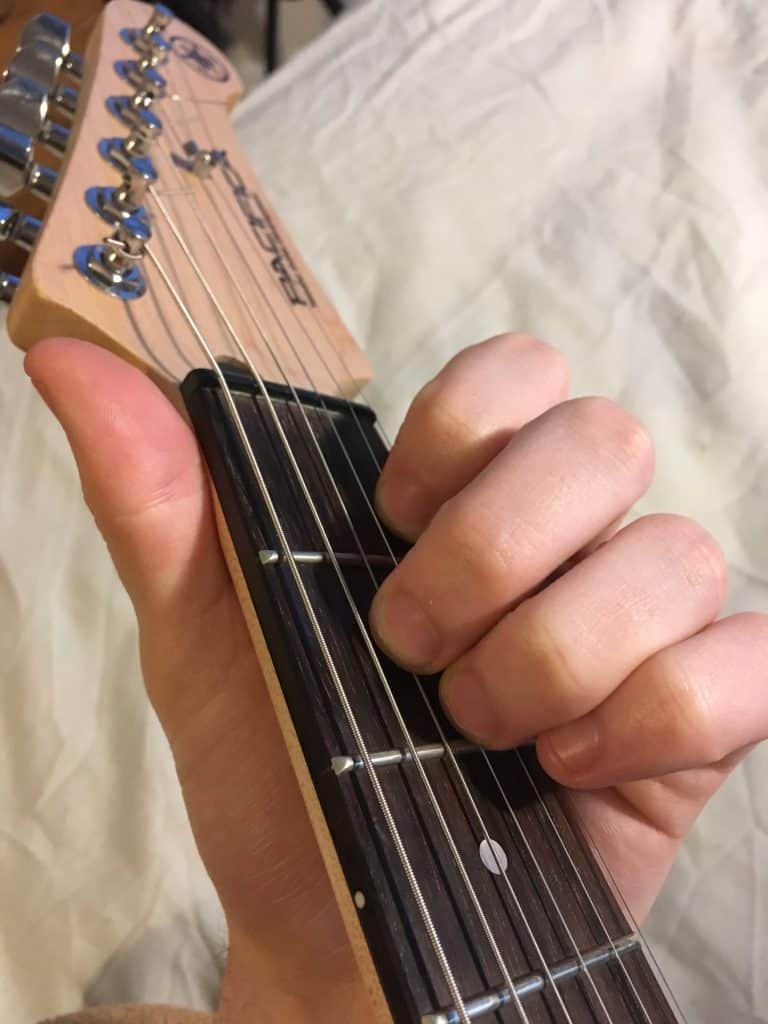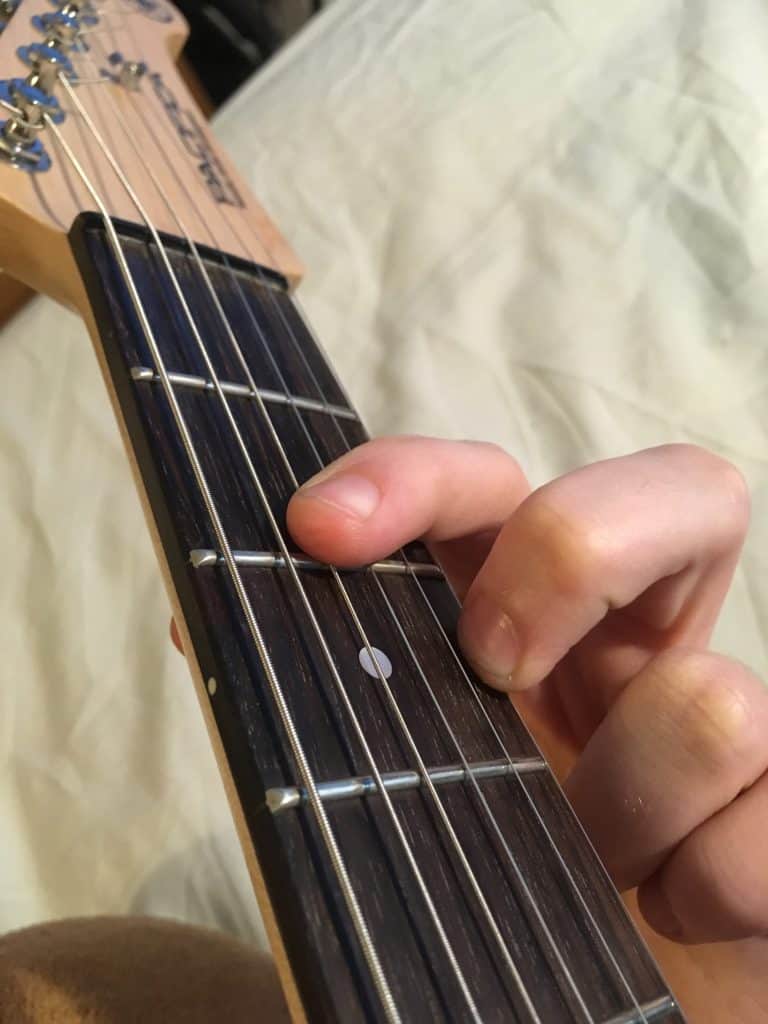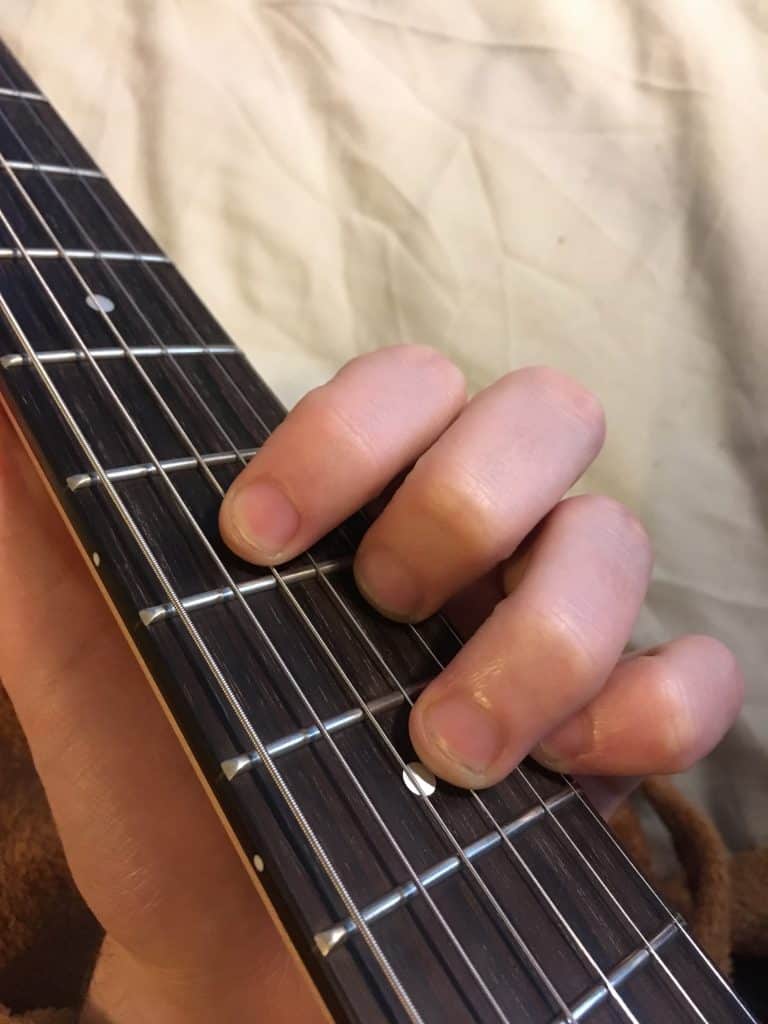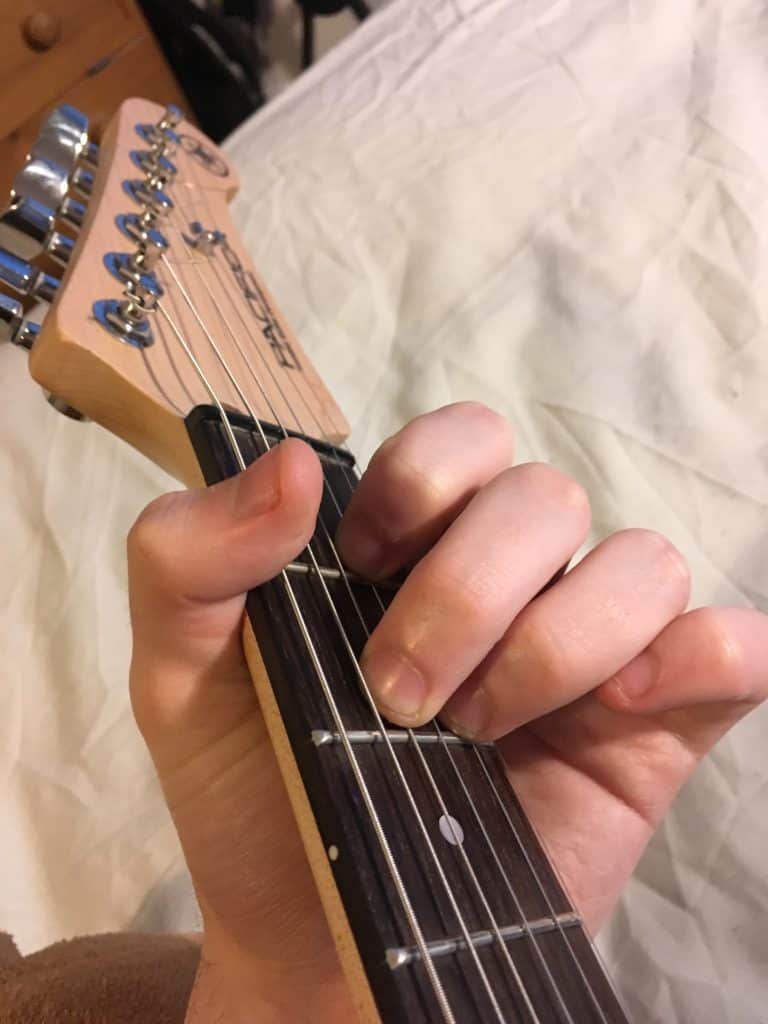There are a lot of chords you’ll come across while learning guitar, but few of them will crop as much as a simple A chord. We’ve done a lot of guides to how to approach playing chords through various techniques, and many different variations on these basic shapes.
In this important guide, I’ll be taking you through a huge number of variants of the A chord:
If you’re looking for a place to start with A chords, then look no further…
Contents
A Major Chord
Every major scale has the same theory behind it, building on a pattern of tones between the notes: 1-1-1/2-1-1-1-1/2. On a piano, the ‘1’ means that if you’re starting on the C, then there will be one note (Db in this case) between your C and the next note of the scale (D), while the 1/2 means that the next note of the scale is directly next door (such as in the move from E-F in C major). On a guitar, the 1/2 means the next fret is in the scale, and the 1 means there will be a fret in between the two notes.
A major: A-B-C#-D-E-F#-G#
Each of these notes (degrees of the scale) can be assigned a number as it ascends so you can use a helpful formula to work out chords from it. The A is a 1, the B is a 2 etc.
Once you’re familiar with the scale, you’ll do well to remember that the formula for an A major chord (and any tonic major chord of any key) is 1-3-5 which gives the notes A-C#-E.
Within the key of A major, you can make various chord sequences and work them out using this numbering system, but remember that A major is your tonic, and is where the key will sound resolved and at home.
Songs That Use A Major Chords
There isn’t much point in choosing to play an ‘A’ chord specifically (unless it’s to house a singer’s range etc.) as the actual note isn’t really going to change the sound of the chord, just the pitch. However, the way you play your chord is important and will determine which styles each variation should be used in.
- Oasis- Wonderwall
- Eric Clapton- Cocaine
- Adele- Someone Like You
- Bastille- Pompeii
- Pink Floyd- Time
- Jimi Hendrix- Foxy Lady
- The Beatles- Here Comes The Sun
- Snow Patrol- Chasing Cars
- Pearl Jam- Black
- Aerosmith- Sweet Emotion
- Daft Punk- Get Lucky
- Pearl Jam- Alive
- Evanescence- My Immortal
- Imagine Dragons- Radioactive
- Linkin Park- Numb
Playing A Major
Variation 1
This open A major chord is a classic shape that you’ve probably already come across, and can be used in any number of different situations. You’ll be able to pick this one up very easily.
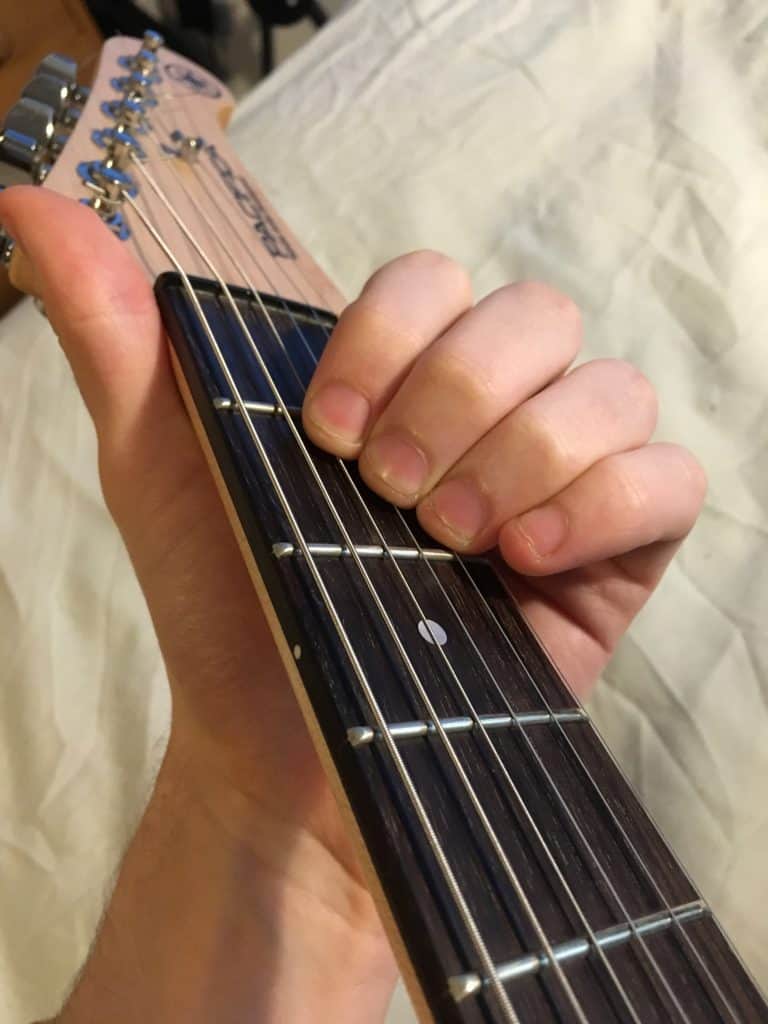
Place your 2nd finger on the 2nd fret of the 4th string, your 3rd finger on the 2nd fret of the 3rd fret and your 4th finger on the 2nd fret of the 2nd string.
Variation 2
This variation of the A major chord is another easily moveable shape that will be able to create major chords on any fret.
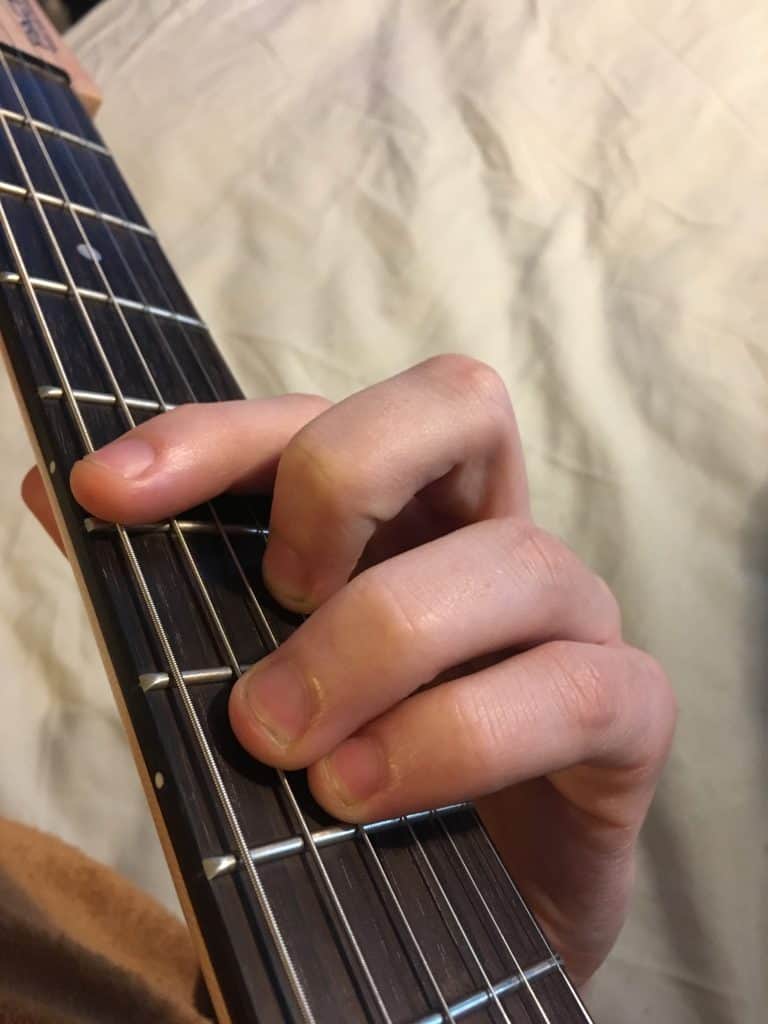
Barre the 5th fret with your 2nd finger, then use your 4th finger to press down on the 7th fret of the 5th string, your 5th finger to press the 7th fret of the 4th string and your 3rd finger to press down on the 6th fret of the 3rd string.
Variation 3
This is another version that requires a bit of stretching, but it isn’t too hard to reach these intervals, thanks to a small barre on the top strings.

You’ll want to use your 2nd finger to barre the 9th fret of the 1st, 2nd and 3rd strings, then your 3rd finger to press down on the 10th fret of the 2nd string. Move your 4th finger over to the 11th fret of the 4th string and your 5th finger onto the 12th fret of the 5th string.
Variation 4
To play this one with ease, you’ll need an electric guitar as you probably won’t be able to reach high enough on an acoustic. This makes this chord pretty good for playing pretty dreamy music, as the fretting is so high. It’s essentially the open A major chord but up an entire octave.
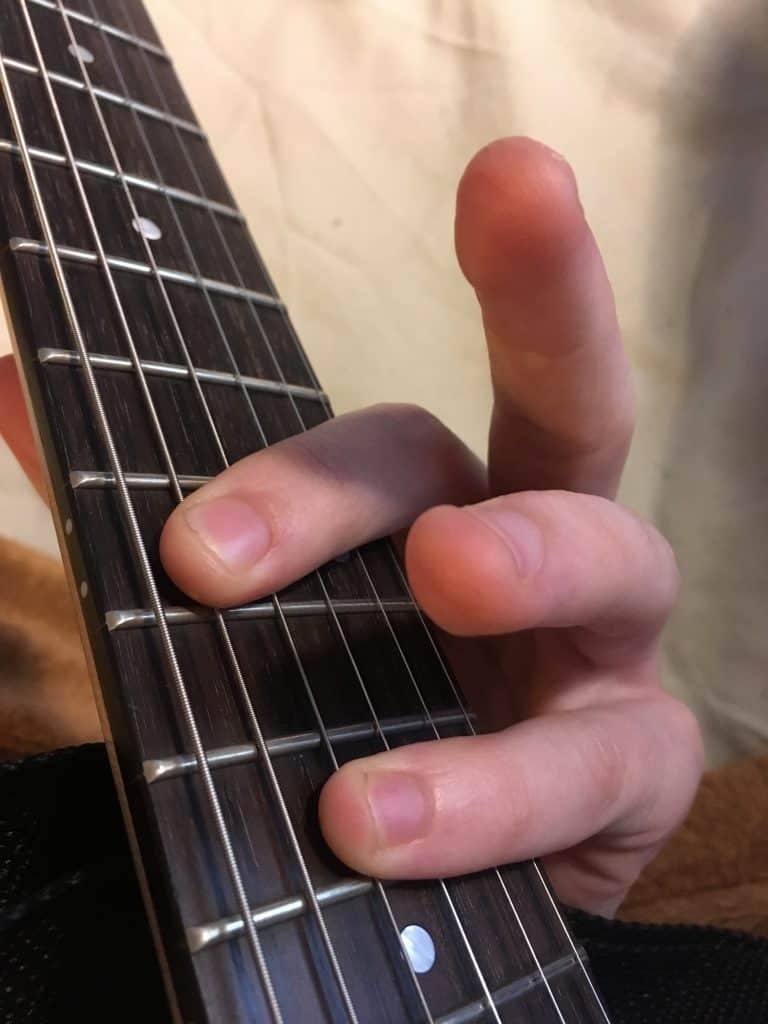
Use your 2nd finger to press down on the 12th fret of the 5th string, then barre across the 14th fret from string 4-2 with your 5th finger. Doing this will mute the 1st string, which is what you want, but make sure to mute string 6 too.
A Minor Chord
A minor scale differs slightly from a major scale in that degrees 3, 6 and 7 are all flattened, so they are lowered by one semitone. This creates the A natural minor scale (variants such as the harmonic and melodic minor will be looked at in a separate guide).
A minor: A-B-C-D-E-F-G
We could apply numbers to these much like we did with the major scale, so an A minor chord would still be 1-3-5, like the major. But this is a bit confusing, so let’s approach it from the context of the major scale.
An A minor chord is 1-b3-5, so therefore made up of the notes A-C-E.
Songs That Use A Minor
Again, rarely does a song seek to use the A note specifically, but rather the minor chord. Whether it is as part of the key and therefore makes sense, or to bring out its sadder sound than a major chord, a minor chord is something important throughout all music.
- Animals- House Of The Rising Sun
- Cat Stevens- Wild World
- Leonard Cohen- Famous Blue Raincoat
- Iggy Pop- The Passenger
- Led Zeppelin- Stairway To Heaven
- Bill Withers- Ain’t No Sunshine
- Tenacious D- Tribute
- Red Hot Chilli Peppers- Dani California
- Santana- Samba Pa Ti
- Dire Straits- Where Do You Think You’re Going
Playing A Minor
Variation 1
Another one of your very first chords is the open Am variant. In guitar music using open chords, you’ll see this one a lot. Each string rings off of each other perfectly, but using overdrive on this one may not be a great idea.
Place your 3rd finger on the 2nd fret of the 4th fret, your 4th finger on the 2nd fret of the 3rd string and your 2nd finger on the 1st fret of the 2nd string.
Variation 2
The barred version of the Am chord is quite an easy one to move up and down the neck, just like its major equivalent. This is a good replacement when you’re using overdrive, as it is a lot easier to mute than the open version.

Use your 2nd finger to barre the 5th fret, then your 4th finger needs to press down on the 7th fret of the 5th string and your 5th finger on the 7th fret of the 4th string.
Variation 3
This one is pretty trick really, but if you can stretch your hands between frets/strings relatively easily, then you should be able to grasp this pretty well. As it only uses the 4 highest strings, this is another one of those nice harp-like chords that give off quite a dreamy sound.
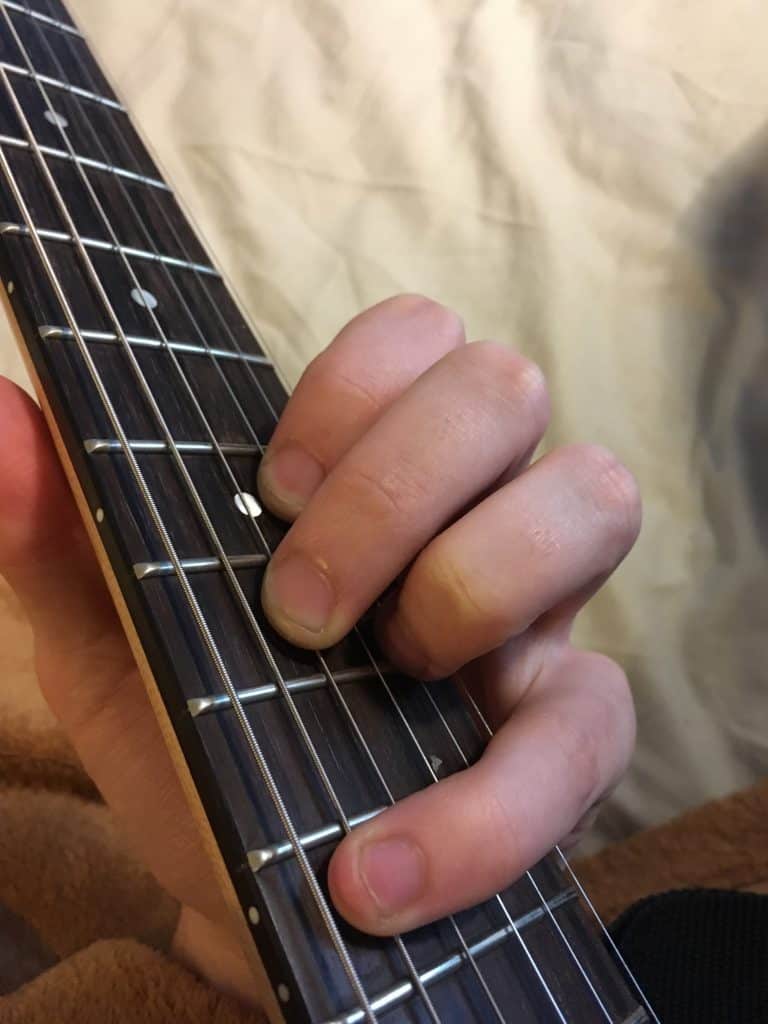
Make a comfortable triangle shape by placing your 3rd finger on the 10th fret of the 4th string, your 2nd finger on the 9th fret of the 3rd string and your 4th finger on the 10th fret of the 2nd string. Then the hard bit comes when you add your 5th finger, which has to stretch over and hit the 12th fret of the 5th string…
Variation 4
Like in its major alternative, this chord is essentially the open A minor chord shifted up an octave. This works well when you’re playing a funky, staccato chordal line, but is also a simple moveable minor chord shape that can be played on lower strings.
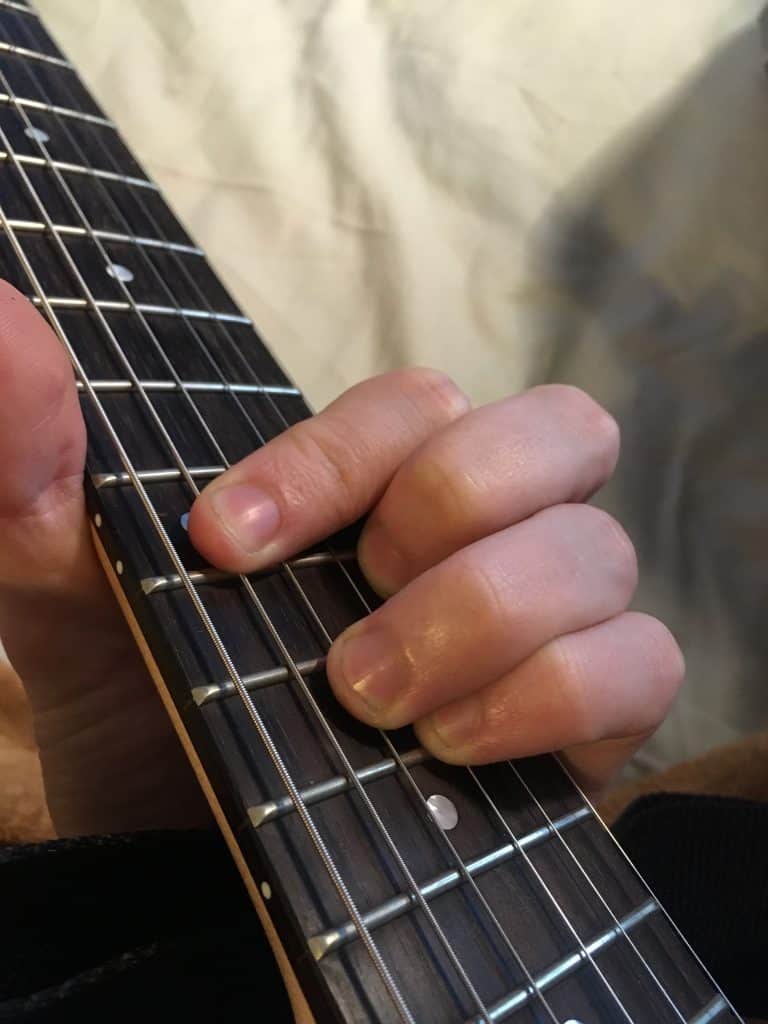
Barre the 12th fret with your 2nd finger, then use your 4th finger to press the 14th fret of the 4th string, your 5th finger to press down on the 14th fret of the 3rd string and your 2nd finger to press down on the 13th fret of the 2nd string.
A7 Chord
An A7 chord, or A dominant 7, is a major chord with an added minor 7th. This creates an interval of a tritone within the chord, adding a laying of dissonance to the sound. In a lot of music, the A7 is used as part of a perfect cadence, in order to resolve to the tonic. However, one of the primary uses of the dominant 7th in modern music, is as a part of jazzy chord sequences.
If we use major scale theory (which we would unless you’re delving into the realm of modality where this chord has a strong Mixolydian quality) then the formula for this chord is 1-3-5-b7. The b7 takes the G# of an A major scale down to a regular G.
This means that the notes in a A7 chord are A-C#-E-G.
Songs That Use A7
A7 chords are popular for use in guitar music as they have a lot of easy variations and are part of a simple E blues/jazz progression. The use of the dominant 7th gives a distinctive dissonance that allows the chord to be use in poignant parts of slower songs, while fit into jazzy, faster numbers.
- Dire Straits- Sultans Of Swing
- The Beach Boys- 409
- The Beatles- Sgt Pepper’s Lonely Hearts Club Band
- Blues Brothers- Sweet Home Chicago
- REM- Everybody Hurts
- The Beatles- Get Back
- Jimi Hendrix- Hey Joe
- Cream- Strange Brew
Playing A7
Variation 1
A7 has a nice open variant that basically simplifies the open major chord by letting one of your fingers rest. This one is good when you’re playing non-jazzy stuff that needs an A7.

Simply place your 2nd finger on the 2nd fret of the 4th string and your 4th finger on the 2nd fret of the 2nd string. Make sure you mute the 6th string, but really let the 3rd string ring out, as that’s your dominant 7th interval.
Variation 2
This variation is similar to the one I’ve just shown you above, but instead of the open string giving you the 7th interval, we get it from a higher string giving a very different tone.
Barre across the 2nd fret from string 1-4 using your 2nd finger, and then add your 3rd finger onto the 3rd fret of the 1st string.
Variation 3
This is the typical barre shape for a dominant 7th chord, so this is yet another moveable shape that you can apply in a lot of different contexts and is really easy to pull off well.
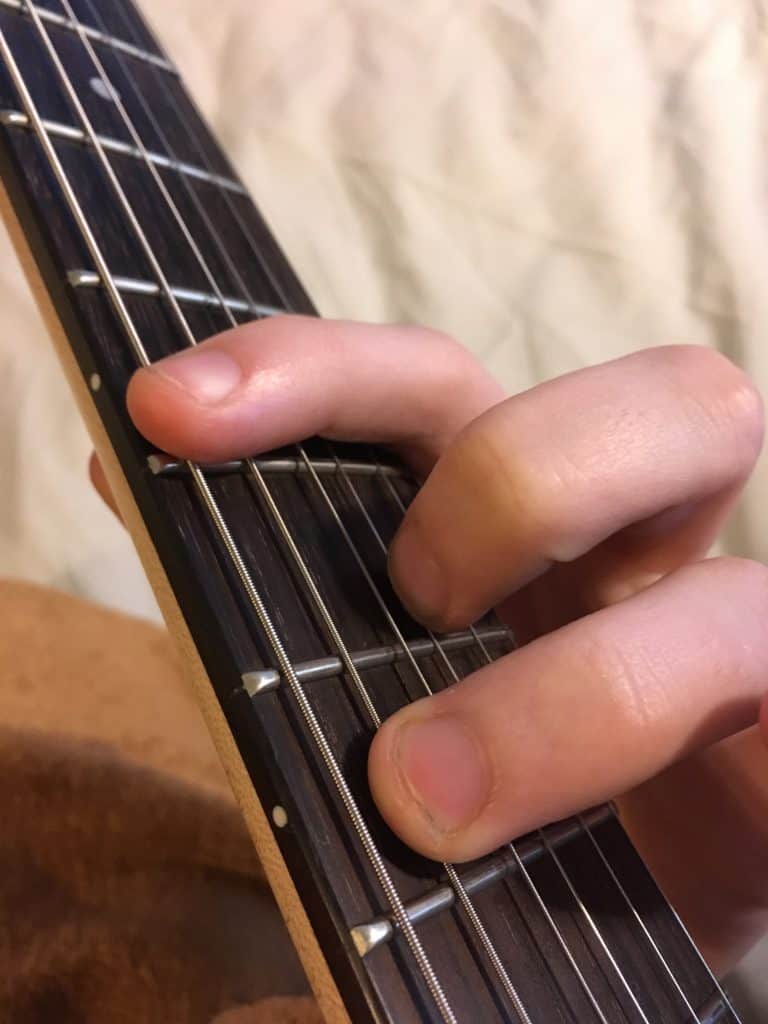
Use your 2nd finger to barre the 5th fret, then add your 4th finger onto the 7th fret of the 5th string and your 3rd finger onto the 6th fret of the 3rd string.
Variation 4
If you’re looking for one of the jazzy, higher shapes then this variation starting on the 7th fret is pretty easy to move about but it requires a bit of a stretch.
Use your 2nd finger to press down onto the 7th fret of the 4th string, your 4th finger on to the 9th fret of the 3rd string, your 3rd finger on the 6th fret of the 2nd string and your 5th finger on the 9th fret of the 1st string.
A Major 7 Chord
An Amaj7 chord is simply a major chord with a major 7th attached to the top. This often gives it a very uplifting sound, but there is an underlying dissonance due to the major 7th interval.
If we look at it from the point of view of the major scale algorithm, then the chord outlines a pattern of 1-3-5-7.
This means that the notes in an Amaj7 chord are A-C#-E-G#
Songs That Use Amaj7
Amaj7 is a good one when used in many contexts due to its ability to slot well into jazz and pop styles. Soul music also finds itself with a lot of maj7 chords chucked in throughout.
- Oasis- She’s Electric
- Bruce Springsteen- Born In The USA
- Porcupine Tree- Lazarus
- The Eagles- Lyin’ Eyes
- Palace Brothers- Gulf Shores
- Rex Orange County- Corduroy dreams
- Band Of Horses- The First Song
- Hey Ocean- Fish
Playing Amaj7
Variation 1
This chord has a nice easy open variation that builds upon the A7 shape and is an easy way of playing the chord during acoustic tunes.
Use your 3rd finger to press down onto the 2nd fret of the 4th string, your 2nd finger to press the 1st fret of the 3rd string and your 4th finger to press the 2nd fret of the 2nd string. Make sure the 6th string is muted.
Variation 2
This is probably my favourite way to play Maj7 chords, and you make recognise its general shape from the open version of Fmaj7. It takes a little bit of a stretch, but it’s definitely doable.

Place your 2nd finger on the 4th fret of the 1st string, your 3rd finger on the 5th fret of the 2nd string, your 4th finger on the 6th fret of the 3rd string and your 5th finger on the 7th fret of the 4th string.
Variation 3
This one requires a strange little barre shape, as it is higher up on the neck than the non-barred notes, but as long you have a fair bit of 5th finger strength it should be no trouble.
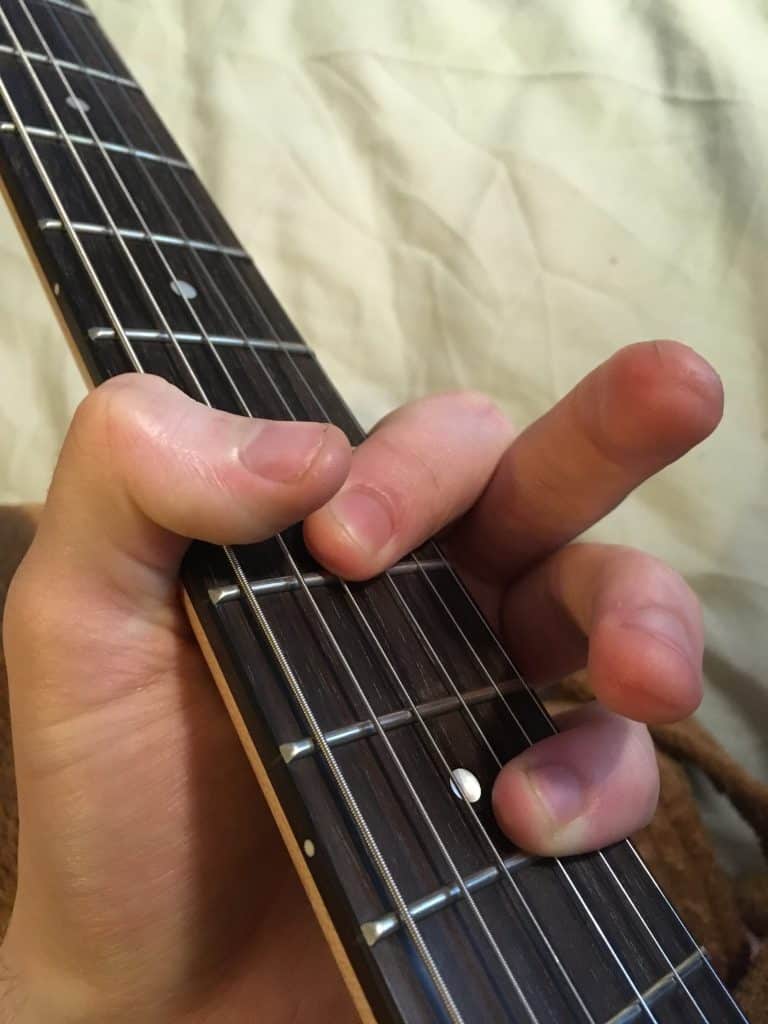
Barre across the 9th fret on strings 1-3 using your 5th finger, and then use your 2nd finger to press down the 7th fret of the 4th string. Make sure strings 5 and 6 are muted.
A Minor 7 Chord
The Am7 chord (A minor 7) is based on a minor chord with a minor 7th above. It’s sort of the sadder version of the major 7th chord, giving off more of a negative sound due to the minor 3rd, but less dissonance due to the minor 7th interval instead of the major 7th.
If we look at it using the major scale formula, then it follows a pattern of 1-b3-5-b7.
This means that the notes in a Am7 chord are A-C-E-G.
Songs That Use Am7
Similarly to Amaj7, Am7 can fit nicely into a lot of jazz music due its 7th interval, but equally it appears a lot in popular music styles as despite its dissonance, it has a pleasant tone.
- The Doors- Light My Fire
- Don McLean- American Pie
- Barenaked Ladies- Brian Wilson
- Elton John- I Guess That’s Why They Call It The Blues
- Extreme- More Than Words
- Goo Goo Dolls- Stay With You
- James Taylor- You’ve Got A Friend
Playing Am7
Variation 1
This is the simplest way to play an Am7 chord, as it essentially follows the same shape as a regular Am chord, but slightly simpler. This is very easy to use in acoustic music, as it is an open chord.
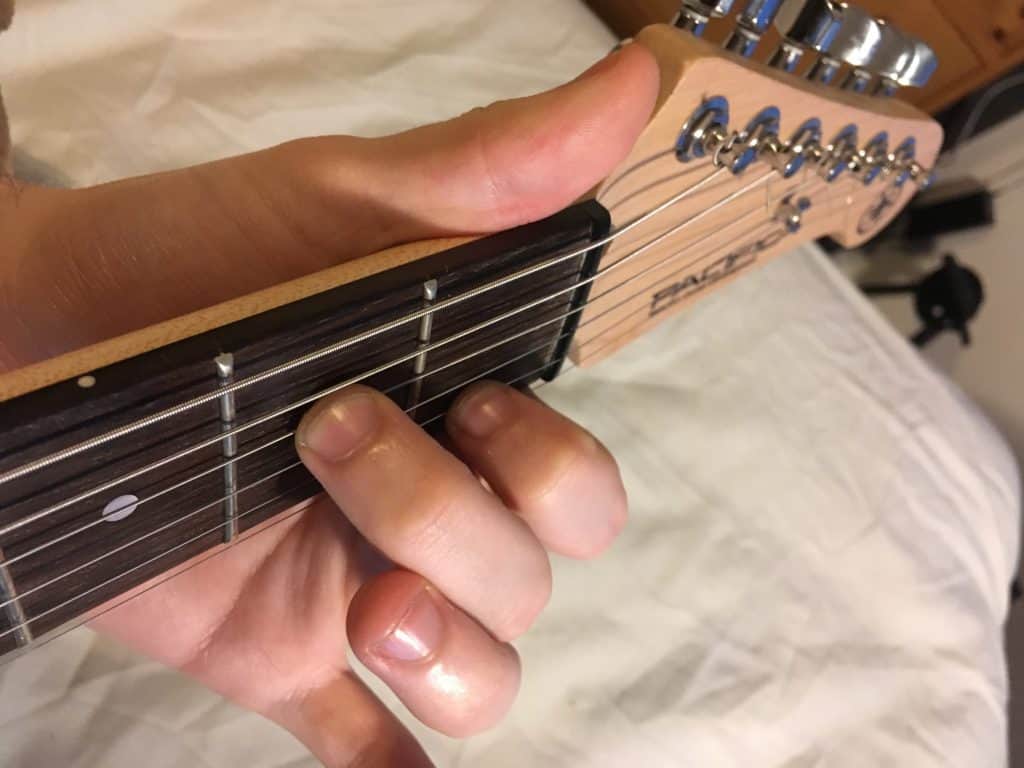
Place your 3rd finger on the 2nd fret of the 4th string and your 2nd finger on the 1st fret of the 2nd string.
Variation 2
This barre shape is a classic moveable shape that allows you to play an Am7 chord on any fret, and is particularly good if you’re palm muting your chords.

Start by barring the 5th fret with your 2nd finger, then place your 4th finger on the 7th fret of the 5th string. Make sure you are pressing down on the 5th fret hard enough on the 4th string.
Variation 3
This is another jazzy variation that allows for easy, sharp plucked chords high up on the neck, and like almost every chord shape, we can move it up and down the neck.

Press down on the 7th fret of the 4th string with your 2nd finger, the 9th fret of the 3rd string with your 5th finger, the 6th fret of the 2nd string with your 3rd finger and the 6th fret of the 1st string with your 4th finger.
Other A Chords
There are a lot of other types of chords you can use based around an A tonic. The ones I’ve shown you so far are probably the most common you’ll come across, particularly major and minor.
- A9 is essentially a dominant 7th with an added 9th (which is essentially a 2nd). The formula is 1-3-5-b7-9 so the notes are A-C#-E-G-B.
- Am13 is a minor 7th chord that adds the dramatic dissonance of a 13th (essentially a 6th, which clashes with the 7th and 5th that surround it). The formula is 1-b3-5-b7-13 and the notes A-C-E-G-F.
- Amaj7sus2 is interesting, as it temporarily replaces the minor 3rd of the Amaj7 chord with a suspended 2nd. This makes the formula 1-2-5-7 and the notes A-B-E-G#.
There are obviously a lot more chords than this, but these are a few I really like. I have a few tricks to bear in mind when working out chords yourself.
- If you’re in an alternate tuning, remember these explanations won’t be the same!
- Using a formula to work out what notes are in a chord is a really simple way to help you out.
- When building chords that are hard to voice, the 5th is the first degree of the chord you are able to drop. Never drop the root, because that will normally completely change the chord you’re playing. For example, dropping the A from an Am7 chord just makes C major…
Good Luck!

Dan is a music tutor and writer. He has played piano since he was 4, and guitar and drum kit since he was 11.
He plays a Guild acoustic and a Pacifica electric. He has been sent to many festivals and gigs (ranging from pop to extreme metal) as both a photographer and reviewer, with his proudest achievement so far being an interview he has with Steve Hackett (ex-Genesis guitarist).
He ranks among his favourite ever guitarists, alongside Guthrie Govan, Jimmy Page, Jimi Hendrix, David Gilmour and Robert Fripp. His favourite genre of music is progressive rock, which he likes to use as a reference point in my teaching, thanks to its huge complexity in structure, rhythm and harmony. However, he is also into a lot of other genres including jazz, 90’s hip-hop, death metal and 20th century classical music.
